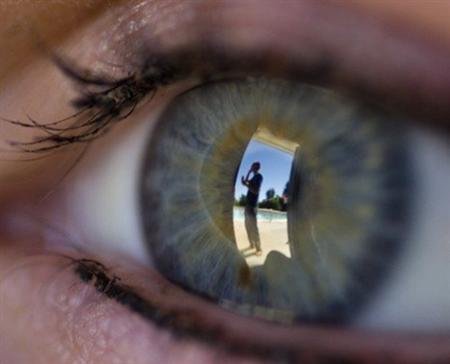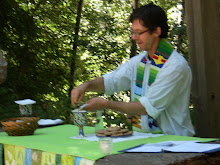There is something
anti-climactic about the story of Easter.
It’s not like the Passion Story that comes before it: now that’s a story, the kind that bears
telling and re-telling. And we did that;
we told and re-told the story of the Passion of Jesus, beginning last Sunday
with a dramatic reading taken straight from the Gospel of Matthew and then re-telling
and re-enacting, in traditional ceremonies of the church (locally-adapted, of
course), the journey from supper at sundown on Thursday, through the long night
of watching and praying in the garden, through the three hours of horror and
sorrow on Friday afternoon, to the peace of Saturday morning, and the silence
of the tomb. It is a tragic story, but
like all great tragedies it is cathartic.
It lets us feel the way we really experience the world a lot of the time
but rarely get to express in community.
So there’s a way in which the betrayal, and trial, and crucifixion, and
burial of Jesus feels like an entirely satisfactory climax to his story.
And yet if it ended there, it
would not be the great story, the
sacred story of two thousand years of religion, and music, of painting and
sculpture, of drama, film, and literature, of the folk art and ritual of
cultures from South Africa to Siberia, and Fiji to Guatemala. It would not be the story that turns ordinary
men and women into saints. Not because
it would be a sad story—the world is full of sad stories, and many of them
beautiful—but because it would be only another sad story among so many. The whole story of Jesus only becomes what is
because of Easter. But what kind of
story does it become? Does it change from a sad story to happy
one? Or from a true story to a myth?
Mary Magdalene and the other
Mary run away from the tomb of Jesus not with fear and not with great joy but
with both mingled together. And this combination
of fear and joy is what accompanies an encounter with what the great rabbi and philosopher
Abraham Heschel called “the sublime”: that which transcends and radically calls
into question our normal categories of experience. Which is why it is essentially irrelevant to
ask, concerning the resurrection of Jesus—“did it really happen?” That is the question of a humanistic age, and
its import is, “is this something we can fit into our conventional human story
of reality?” When you put it like that,
the answer is clearly “no.” But if the
answer is “no; the resurrection does not fit into the story we human beings prefer
to tell about ourselves,” it is because it is the answer to a different kind of
question. The resurrection comes into a
human story, the story of Jesus and his disciples, but it is not our question to
ask about that story. The resurrection
is the essential question that story asks about us.
The story of Jesus and his
disciples is our story, because it raises the essential questions put to us by
our own existence. They are the questions
asked of us by being alive and being human: by our experiences of joy and love
and healing, of freedom and forgiveness, and belonging in community; and our experiences of fear and hate, affliction
and loss, of conflict and oppression and despair, of missing the mark, and
being at loose ends. These experiences, and
the way they all somehow come together as the one experience of being alive and
being human, also come together as a single question; a question that is bigger
than we are, that we cannot answer and don’t even really know exactly how to
ask.
Reading the Bible is one way,
our way, of entertaining that question, of letting it live, and work on us, so that
we are not simply drifting half-asleep down our passage through this world
being satisfied with our own answers to our own superficial questions. For Christians the story of Jesus and his
disciples is the crystallization of the question that the Bible asks us. And in the story of the resurrection we find
our answer. And the answer is
“yes.” “Yes.” The resurrection is God’s “yes” to the
question of what it means to be human, a “yes” we can give in answer because we
believe it was first given to Jesus, and then to his disciples, by God.
Just for that reason, faith in
Christ’s resurrection is not a mental exercise, not a matter of convincing
oneself that “I believe it really happened.”
We can believe that, but just as it is the answer to the question posed
to us by our whole lives, it is an answer we must give with our whole
lives. That is why St. Paul urges us, in
the Letter to the Romans, to understand that when we were baptized we died and
were buried with Christ. Which can’t have “really happened,” because
here we are, alive. So Paul must not be speaking
to our rational intellects, to the part of us that asks and answers our own
questions. Rather he is speaking to the
heart of our consciousness, to that inner image we have of being “I”, a person,
unique and entire unto myself, who is alive and has a life story.
And what Paul is saying is
that to be “in Christ,” to really know and really live in God’s grace and
spiritual power, it is not enough to accept the certitude of doctrinal
assertions about Jesus. It is not even
enough to obey him as the authoritative moral teacher, and to attempt to practice
what he preached. These things are valuable and even necessary,
but in and of themselves they are not enough.
Because what it really means to be “in Christ” is to surrender
everything we are to God. All of it—even
that deepest, most essential heart of our being, that very sense of being a
person who owns the copyright on the story of “me.” If we give that up to God, with the nakedness
of faith we see in Jesus, praying in the garden, “not my will, Father, but
yours be done”; if we say “yes” to God with the abandon of love that we see in
Jesus on the cross, we will get it back.
It will be very like what it
was before. We will be the person we
always were, the same weak, gifted, happy, sad, simple, complicated, stupid,
brilliant, virtuous, sinful person. The same
mere mortal—only completely new. We will
be raised with Christ. United with
Christ. “It is not I who live,” says
Paul in Galatians, “but Christ who lives in me.” And in Colossians: “You have died, and your
life is hidden with Christ in God. When
Christ who is your life is revealed, then [who you really are] will be revealed
with him in glory.”
“The glory of the Father,”
says our passage from Romans today, is what raised Christ Jesus from the
dead. Which is a curious way to put
it. Why the “glory”? Why not the power, the mercy, the love, or
the justice? I think to understand what Paul is saying here
we need to know that glory is not just one among many attributes that we assign
to God by analogy to human characteristics.
The Glory of God is what belongs to God alone. You could say Glory is God, because in so far as human beings can see God, Glory is
what we see. But what Christ’s death and
resurrection renews in us is the knowledge that God does not keep his Glory to
himself, but gives it away. We may be
looking upward at heaven, or outward at the earth, or inward at the uncreated
image in ourselves, but if ours are the eyes of a heart that says “yes” to God,
what we see is Glory.
Mary Magdalene and the other
Mary, arriving the tomb, experience it first as a kind of anticlimax, the emptying
out of their expectations for how the story of Jesus will end. But then, running away from the tomb with their
strange new message, they meet the glory of God in person. He greets them: “Hey!”—just the way one
person would greet another on a bright spring morning on a garden path. And they fall to their knees and prostrate
themselves before him in the first-ever act of Christian worship. But they also grab onto his feet, just to be
sure.



No comments:
Post a Comment